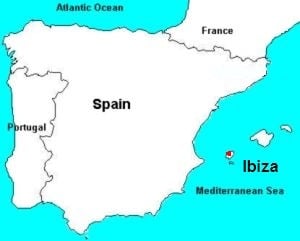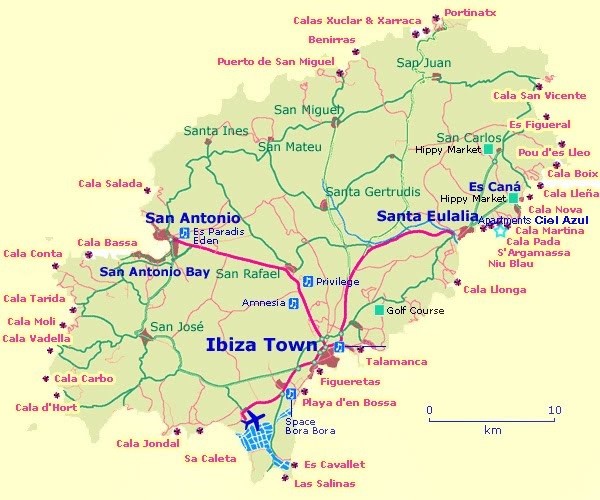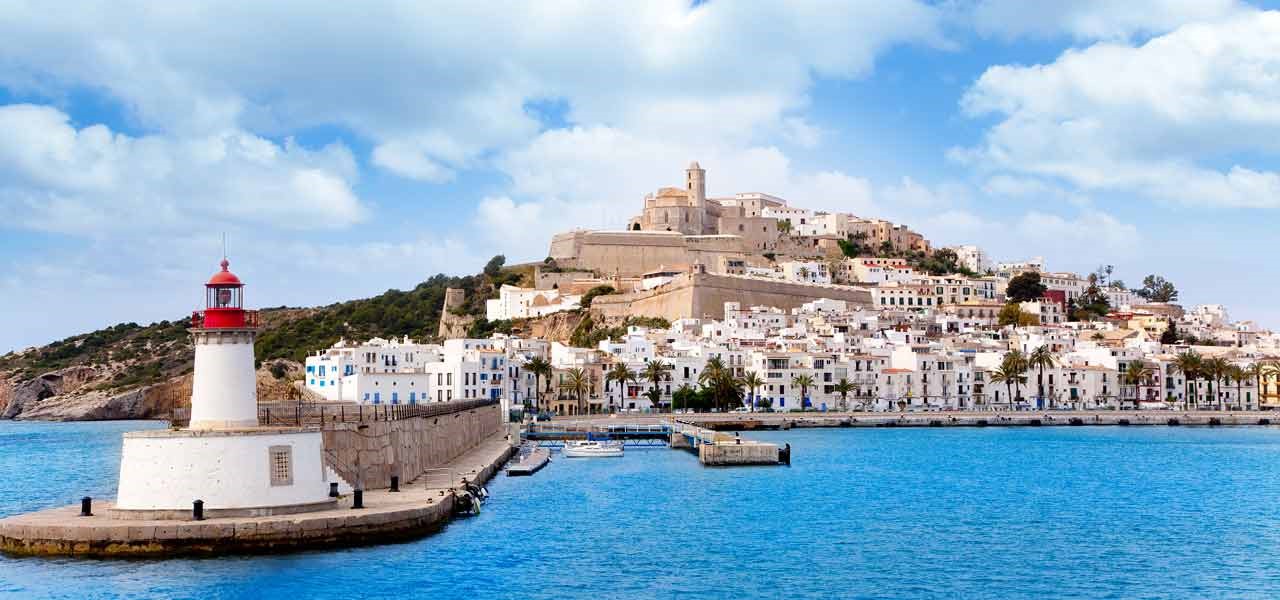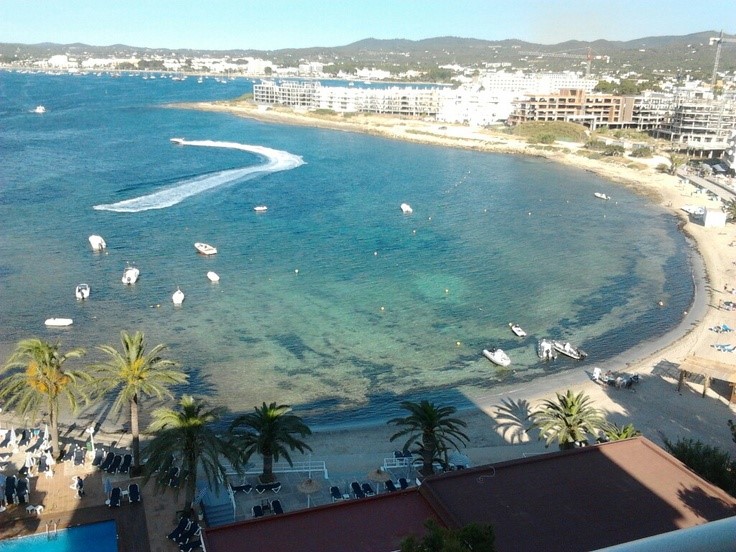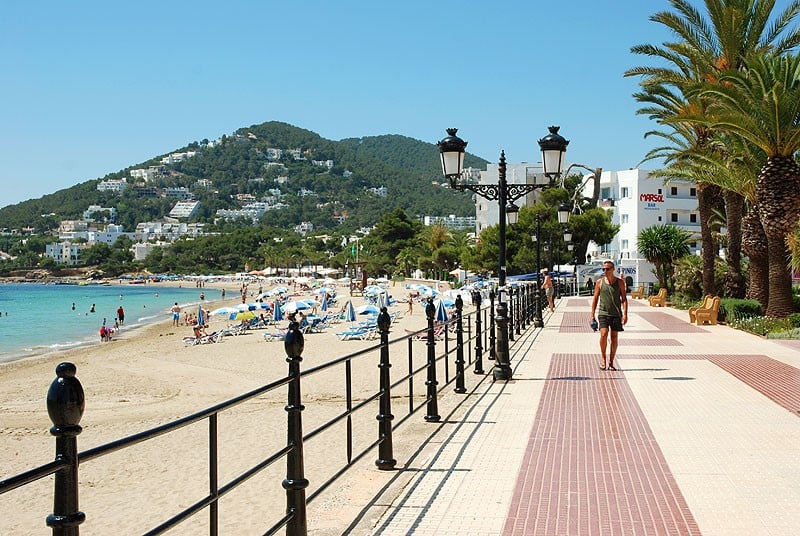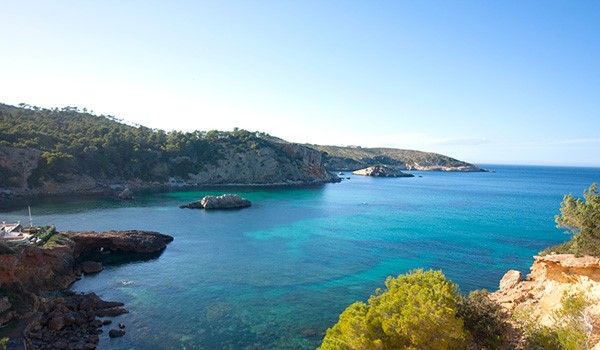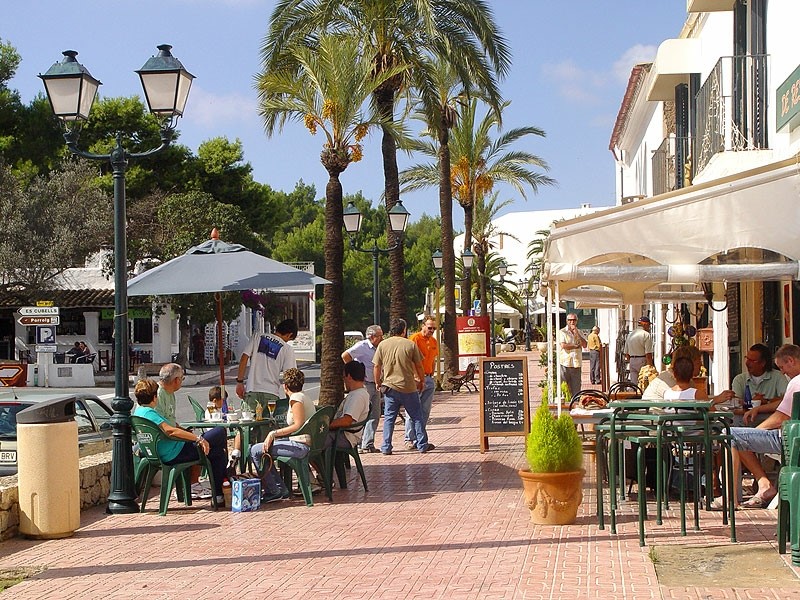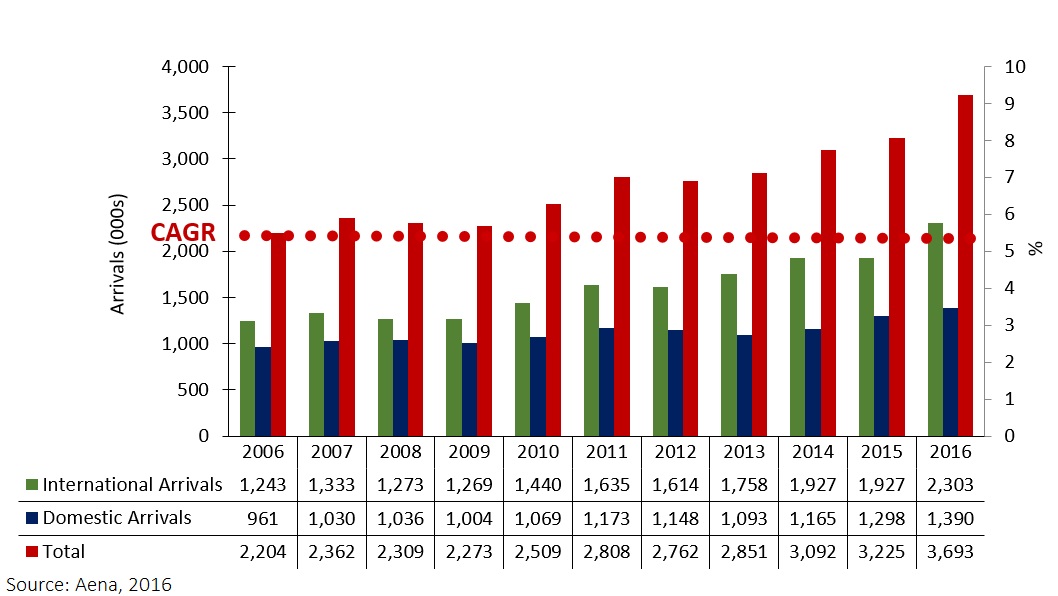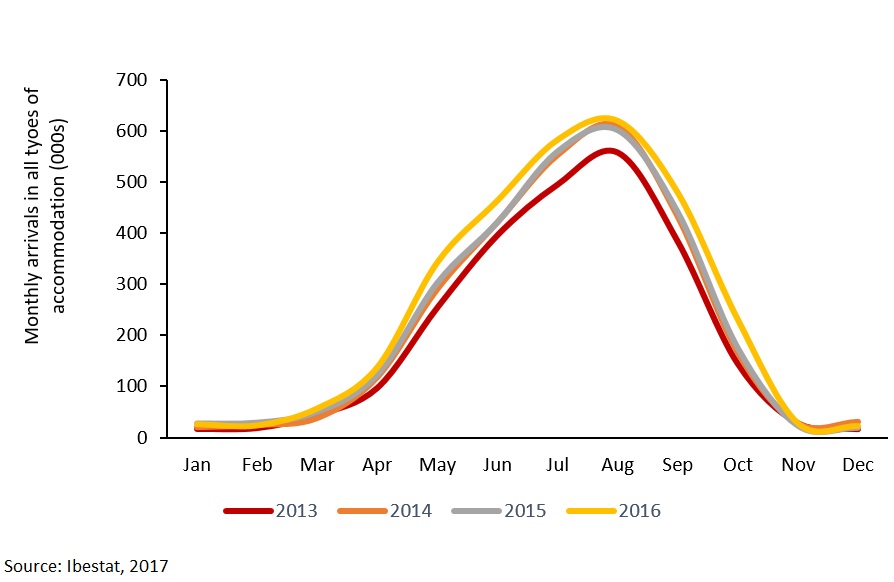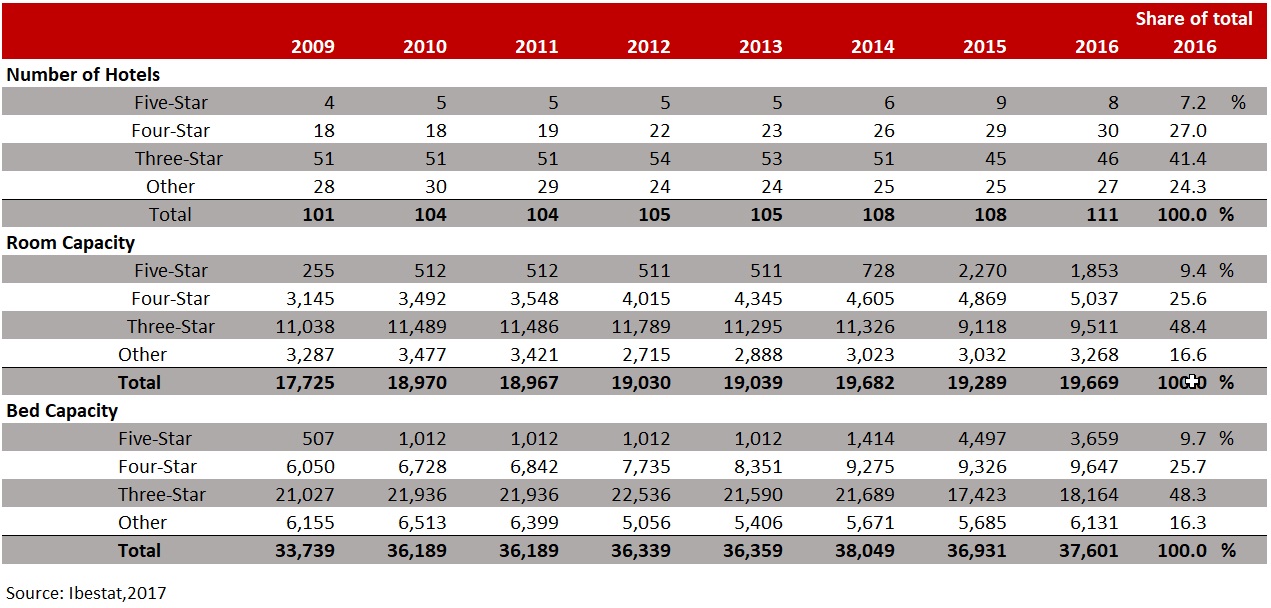By Ezio Poinelli, Nana Boussia, and Paolo Buffa di Perrero
Introduction LOCATION OF IBIZA
Ibiza is an island in the Mediterranean sea off the east coast of Spain and is the third largest island of the Balearic Islands (Mallorca, Minorca, Ibiza and Formentera), an autonomous community of Spain. The island comprises five municipalities: Ibiza or Eivissa (Ibiza town), Santa Eulària del Rio, Sant Antoni, San José and San Juan Bautista while it covers an area of 572 km² and has 210 kilometres of coastline. Its population is 141,000 , of which around 76% are Spaniards while 24% are foreign residents. The island’s major cities are Ibiza Town (the capital), Santa Eulalia del Rio and Sant Antoni de Portmany. Ιbiza is often referred as either the “White Island” because of its white buildings and typical smooth domed architecture or as the “Pine Island” because of its abundance in pine trees. The island became a major tourism destination during the 1960’s famous for its ‘hippie-culture’ and its vivid nightlife which continues up to date. Today Ibiza is a world famous destination offering a mild climate, exotic beaches, traditional Mediterranean lifestyle, beautiful scenery and a famous party scene. The cultural richness and biodiversity of Ibiza was declared a World Heritage Site in 1999. Due to its geographical location, Ibiza and Formentera have always been a key strategic point on transport routes from east to west Mediterranean.
By AirIbiza Airport is the eighth-busiest airport in Spain in terms of passenger arrivals. The airport is seven kilometres from the centre of Ibiza Town, on the southwest tip of the island. The airport opened in 1958 during the great tourism boom in the Balearic Islands. Nowadays, visitors to Ibiza arrive primarily by plane (95% of total arrivals). Some of the airline companies that fly to and from the airport are the following: AirBerlin, AirEuropa, Air Nostrum, BA CityFlyer, British Airways, easyjet, Edelweiss, Eurowings, Evelop, Germania, Germanwings, Iberia, Jet2.com, KLM, Lufthansa, Norwegian Air Shuttle, Ryanair, Skywork Airlines AG, Swifair, SunExpress, Thomas Cook Airlines, Thomson Airways, Transavia.com, Vueling.
By Sea
The three main ports are the ports of Ibiza, Santa Eulalia and Sant Antoni. The ferry companies -Balearia, Iscomar and Acciona- sail to the ports of Ibiza and Sant Antoni from different places on mainland Spain. Apart from the ferry crossings, it is also possible to reach the island by private ship, chartered crossings and various cruises. The regular sea crossings reach the island of Ibiza from Barcelona, Valencia, Dénia and Palma de Mallorca.
Main Regions and Attractions
Ibiza old town, the capital of Ibiza island with its walled area (Dalt Vila) declared UNESCO World Heritage Site, located on the south of the city, in the municipality of Ibiza. It is known as the place where the posh night life scene evolves with a plethora of hotels, restaurants and bars bursting around the city featuring the latest trends of the hospitality or food and beverage industry. The city houses the main institutions of Ibiza and offers variety of services for the visitors and residents such as yachting marinas, business zones and hospitals. Some points of interests within area are: Ibiza Old Town, the Necropolis of Puig des Molins, Ibiza City Center, the Port of Ibiza and La Marina district and the Yaching Marina.
San Antonio Bay, also known as Sant Antoni de Portmany, is located on the centre west coast of Ibiza. It is the second largest town of the island by means of population and chief leisure entertainment centre targeting the budget traveller and the young holiday makers who is looking for affordable solutions when visiting the island. San Antonio is also famous with its famous Sunset at Ses Variades (Sunset Strip), the villages of Santa Agnes de Corona and Sant Mateu d'Aubarca, Ses Torres d'en Luc Archaeological Site and Cala d'Aubarca Cove, Aquarium Cap Blanc, the churches of San Antonio, the village of Sant Rafael de Sa Creu, Cueva de Ses Fontanelles Cave, the Egg of Colombus.
Santa Eulalia, also known as Santa Eulària des Riu is located on the centre east coast of the island and has a long-established reputation as the island's gastronomic and cultural centre. The city boasts several art galleries, some of the island’s best restaurants, a picturesque yacht marina but it is widely known for its palm-lined promenade running the length of the broad and sandy beach. This area is considered as one of the quieter and at the same time sophisticated destinations for laid-back holidays away from the party congestion observed in the previously mentioned areas. Es Puig de Missa is the popular sight of Santa Eulalia located on the hill crowned by a church dating back to 16th century. The charming villages of Sant Carles de Peralta, Santa Gertrudis de Fruitera and Jesus, the Markets of Santa Eulalia (Las Dalias and Punta Arabi), Ethnology Museum of Ibiza and Barrau Museum are the other popular attractions and sights.
Sant Joan, also known as Sant Joan de Labritja is the most rural part of Ibiza located on the northern part of the island. The municipality hosts the lowest number of inhabitants and offers the wildest natural landscapes, great flora and fauna and with spectacular cliffs that have been declared as a Natural Area of Special Interest. The Settlement of Balafia and Cova de Can Marça Cave some of the attractions in the area.
Sant Josep, also known as Sant Josep de Sa Talaia is located on the south west of Ibiza. It is the administrative town and the largest municipality of the island. The municipality of Sant Josep de Sa Talaia is the most extensive on the Ibiza island and the one that boasts the greatest number of beaches within its 80 kilometers of coastline. The town is established under the highest mountain of the island. Sant Josep shares the Playa d'en Bossa beach with the municipality of Eivissa and Sant Antoni's Bay on the west. Playa D’en Bossa is known as the place where some of the most prominent resorts of the island are located. These hotels allocate large resources to the entertainment division by developing designated spaces for this activity within the properties and converting the hotel to a multifunctional space and ultimately a destination by itself.
Demand for Transient Accommodation
Ibiza’s Airport has a very high flight frequency in the summer months and a low frequency in the low season, as a result of the market’s strong seasonality. According to the Airports Council International 2013 report, Ibiza Airport has one of the highest seasonality ratios in the world. Nevertheless, it seems that this trend is changing as more low-cost carriers launch new routes with higher flight frequencies per week for a number of destinations. During the last 11 years, there has been a remarkable growth in international arrivals while domestic arrivals also grew in a more moderate pace. More specifically during the examined period, international and domestic arrivals have recorded a CAGR by 6.4% and 5.3% respectively. It is worth mentioning that only during the last year international arrivals in the island grew by almost 20% showing the potential of the island. As at the end of March 2017, three new routes were added: Sevilla, Edinburgh and Rome- Fiumicino. The routes will be operated during the summer schedule.
FIGURE 1: DOMESTIC AND INTERNATIONAL ARRIVALS 2006-16 (000S)
Ibiza International Airport
Basic Visitation Factors
FIGURE 2: ARRIVALS IN ALL TYPES OF ACCOMODATION – IBIZA & FORMENTERA 2011-16 (000S)
Total visitation to Ibiza and Formentera increased significantly from 2011 to 2016, reaching three million arrivals in 2016. This increase was primarily driven by international demand, which accounted for 78.5% of total arrivals in 2016 while domestic visitation has remained relatively stable during this period with a slight decreasing trend. Pre-bookings for 2017 show that this growth in arrivals is expected to continue the following year. Overall, statistics show that nearly 97% of all visitors are travelling to Ibiza for leisure and holiday purposes, a trend which has been consistent over recent years.
Ibiza and Formentera are served by the same airport, therefore arrivals in all types of accommodation refer to both destinations. With a population of just over 7,000 and no airport, Formentera is usually quieter than its neighbor Ibiza. The island of Formentera can be reached by regular feries from the Estacion Maritima in Ibiza Town but also by tourist ferries from other parts of Ibiza during high season. Formentera has a total of 17 hotels,with 2,404 beds, 12 out of which are classified as one, two and three star properties, five are classified as four-star hotels while the island does not feature any five-star properties.
The breakdown of arrivals depending on the type of accommodation is depicted in Figure 3. The CAGR for the period 2011-16 was 4.8%, driven both by the increase in arrivals in hotels and similar establishments but also by the rise of sharing economy as an accommodation choice and the subsequent increase in the number of travellers choosing to stay in rented apartments.
FIGURE 3: ARRIVALS BY TYPE OF ACCOMMODATION – IBIZA & FORMENTERA 2011-16 (000S)
Main Source Countries
Ibiza had always been a popular destination among British and 2016 has been a record-breaking year for arrivals from the UK with almost 840,000 British, 12% up from 2015, visiting the region representing 27.7% of total. For the domestic market, Ibiza is a traditional summer destination and is well connected by plane and boat, thus it is the second most important feeder market to the island. Given the country’s post-crisis economic growth, Spanish people have witnessed an increase in the domestic income giving them the opportunity to travel again to to expensive destinations like Ibiza. For 2016 Spanish tourists represented almost 22% of total visitation followed by Italians with 13% and Germany with almost 11%.
FIGURE 4: MAIN SOURCE COUNTRIES 2016
Seasonality
FIGURE 5: SEASONALITY IBIZA 2013-16 – ARRIVALS IN ALL TYPES OF ACCOMMODATION
The seasonality in Ibiza is very pronounced with the peak season being in the summer months as the island is mainly a sun and beach destination. Figure 5 depicts the seasonality pattern of the island for the last four years based on monthly arrivals in all types of accommodation. Minor changes have been recorded to the visitation pattern of the island during this period putting a strain on the hotel industry which mainly operates from April to October. Local or regional authorities and private enterprises are trying to alter this situation by undertaking a series of measures to lengthen the tourism season like the increase of number of direct flights towards various destinations during the shoulder months, the strongest positioning of Ibiza in various niche markets (wellness, mice, adventure) by targeting sophisticated travellers seeking for differentiated experiences or the opening to new markerts that do not travel exclusively during the summer peak season and are attracted to alternative forms of tourism that could be developed off season.
Hotel Supply
Figure 6 summarises hotel supply in Ibiza over the past eight years. The table below accounts for star-rated hotels only and thus excludes other types of accommodation, such as aparthotels, hotel residences, camping facilities and pensions.
The majority of hotel units are of one-star, two-star or three-star classification; however, five- and four-star hotel units together constitute the ones with a significantly considerable number of available rooms and beds. During the examined period , development of five-star and four-star units has recorded significant growth demonstrating the evolution of the island to a high-end destination . In general, five-star hotel rooms and beds in Ibiza have almost doubled in number during the period of 2009-16 revealing the intensive investment interest in the region by hoteliers and investors. In 2016 the average room number of a five-star hotel was 231 while average bed number was 457. Both numbers are significantly higher than the average hotel size in 2009 (63 and 126, respectively).
FIGURE 6: HOTEL SUPPLY – IBIZA 2009-15
Branded Properties
Despite the fact that Ibiza is considered as one of the most upscale leisure destinations within Europe, almost none international high-end brand has presence in the market. The majority of hotel properties in the island, are currently operated by Spanish companies using local brands with some of the most prominent being the following:
Palladium Hotel Group is a multinational corporation established over forty years ago with the aim of promoting the island of Ibiza in Spain and across Europe. Over the years it has cemented a position as one of the best-known Spanish companies worldwide. In Ibiza they currently operate 11 properties in various locations around the island under the following brands; five under the Palladium Hotels brand featuring four-star and five-star properties dedicated to family or couple holidays with all-inclusive options; four under the Fiesta Hotel and Resorts brand featuring three-star beach hotels and resorts on the sea front targeting families and couples; one under the Ushuaia Beach Hotel brand, a five-star luxurious music-themed resort targeting young, sophisticated clubbers and one under the Hard Rock Hotel brand, a five-star property which is the first Hard Rock Hotel in Europe and franchise of the Hard Rock International Brand, operated by Palladium Hotel Group. Hard Rock Hotel with 485 rooms and Ushuaia Beach Hotel with 417 rooms, both located in Playa d’en Bossa, were former three-star properties which following extensive remodelling and refurbishment were converted to five-star resorts and since then are considered to be among the leaders of hospitality in the island in terms of innovative design, music events, operational performance and high-end services.
Meliá Hotels International is a local hotel company with significant international presence. It is largest hotel chain in Spain in both resort and city hotels. The company currently operates more than 370 hotels in 43 countries and 4 continents under its brands: Meliá, Gran Meliá, ME by Meliá, Paradisus, Innside by Meliá, TRYP by Wyndham, Sol Hotels and Club Meliá. The company features three hotels in Ibiza; two four-star properties under the Sol Hotels brand totalling 514 rooms and one five-star under the ME by Meliá brand totalling 205 rooms.
Insotel Hotel Group, currently has nine hotel complexes with prime beach front locations on the islands of Mallorca, Menorca, Ibiza and Formentera (Balearics, Spain). In Ibiza they operate three properties; two five star properties totalling 568 rooms and one four-star property featuring 172 rooms.
Pacha Group, the Ibiza-based company behind the world-famous nightclub franchise which has been recently sold to venture capital firm Trilantic Capital Partners for €350 million and is considered to be the pioneer of entertainment in Ibiza operates two properties in the island; the four-star hotel El Pacha with 55 rooms and the four-star Destino Pacha Ibiza Resort with 164 rooms.
Hotel Montesol in Ibiza town was the first hotel in Spain opened under the ‘Curio’ brand by the Hilton Group, the only international brand with presence in the island. It opened in 2016 the ‘Gran Hotel Montesol Ibiza’ and has 33 rooms while it is one of the few properties in the island open all year round.
Following the remodelling of an already existing property Iberostar Hotels and Resorts entered the market of Ibiza in 2016 with a four-star hotel located in Santa Eulalia featuring 188 rooms.
Recent and Forthcoming Tourism Developments
- Ibiza’s most recent addition five-star supply is Nobu Hotel Ibiza Bay, a member of Nobu Hotels which opened on 30th June 2017 on Talamanca Bay. The hotel features 152 rooms and is operated by MC Hotels;
- Sir Joan hotel, a five-star property located on Talamanca opened in June 2017 and features 38 rooms;
- 7 Pines Resort, a five-star resort complex due to open in 2018. Located above Cala Conta Beach, in the southwestern part of the island, 7 Pines Resort Ibiza will offer a choice of three villas, 42 suites and 160 apartments, accommodating a maximum of 500 guests. Some of the holiday properties also offer private plunge pools and spacious terraces.
- Cine Serra, a former cinema located in Ibiza city will open as a five-star hotel in 2018 featuring 50-60 rooms.
- Six Senses Hotels Resorts Spas has announced the development of Six Senses Ibiza. Expected to open in 2020, the resort is located on the northern tip of Ibiza, Spain in the Cala Xarraca B. The resort will feature 134 rooms and nine private villas for sale located above the resort.
It is rumored that several other high-end brands are looking for investment opportunities in Ibiza’s hotel market.
High end Hotels Performance
Figure 7 summarises the important operating characteristics of a sample of high-end hotels in the broader region of Ibiza. The chart sets out the average occupancy, average room rate, and rooms revenue per available room (RevPAR) for a sample of 13 major upscale hotel properties representing in total 2,896 hotel rooms. For consistency reasons, despite the seasonal operation of the specific hotels all occupancy percentages refer to 365 days of operation.
Performance of the selected hotels in Ibiza throughout the examined period is showcasing a constant improvement. During the last four years occupancy and average rate have witnessed a CAGR of 17% and 1% respectively leading to cumulative increase of the RevPAR by 19%. Occupancy levels have remained relatively stable throughout this period due to the seasonal limitations the area is confronting. At the same time, the island is witnessing an unprecedented growth which is clearly reflected in the performance of the average rate. By not being able to absorb the demand during the high season, hotel executives are constantly pushing for higher rates leading to the increase of the average rate for 2016 to over €400. Aggregated seasonal occupancy for 2016 was recorded at 79% for 183 operating days . Three top performers in the market reached occupancy levels between 78% and 82% and ADR between €500 and €650. Preliminary data indicate that this growth in the average rate is going to continue the upcoming season. The island’s continuous progress has also resulted in an increased appetite for hotel investments in the area which has led to the introduction of several high-end properties in the hotel market supply. Nonetheless, the region lacks a significant number of international hotel brands which could boost its upscale profile and recognition, thus leading to even higher levels of sales efficience and operating performance.
FIGURE 7: HOTEL PERFORMANCE – IBIZA HIGH-END HOTELS 2013-16 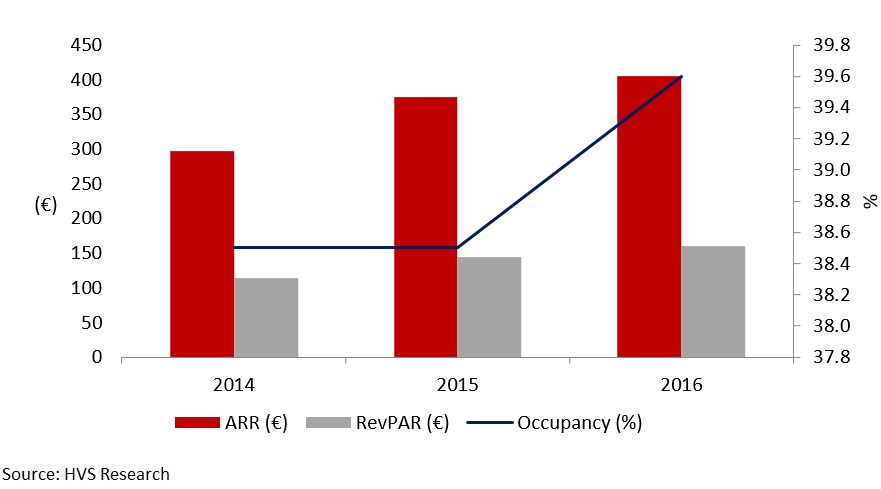
Ibiza is a well-established destination with strong levels of occupancy and a high number of repeated guests, mainly in the summer months. Over the past years, the destination has managed to differentiate itself from its previous reputation as an island mainly offered for low-budget, party-centric holidays and is now considered as one of the most upscale destinations within Europe. Despite the highly-priced holidays that Ibiza offers, seasonal occupancy especially in the most famous parts of the island, reaches peak levels which leads to a very congested destination making it hard for tourists to move from one place to another. Due to the high levels of tourist demand, new international flights are announced on a yearly basis while the destination is in the process of penetrating new prosperous markets. UK is Ibiza’s main international source market and therefore generates the strongest demand. However the recent Brexit has created concern for the future of the specific market in the island and the impact it will have on the visitors’ travel patterns. With all the recent high-end tourism-related developments in the island, ranging from luxury meditation retreats on the north to music-themed sophisticated resorts in the south, we can easily justify why Ibiza is included in the prime leisure destinations in Europe. During the last decade lower category hotels have been either closing or reconverted to high-end properties. This, combined with the absence of branded properties and the efforts that are being made to overcome the seasonality issues, witnesses that Ibiza is yet to unfold its full potential as a leading destination.


